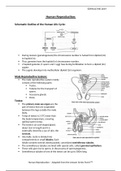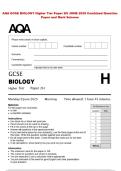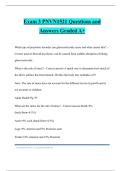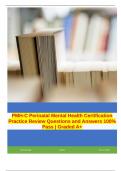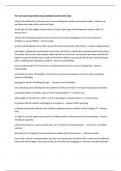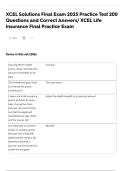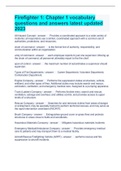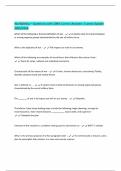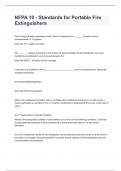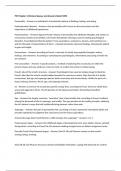Human Reproduction:
Schematic Outline of the Human Life Cycle:
During meiosis (gametogenesis) the chromosome number is halved from diploid (2n)
to haploid (n).
Thus, gametes have the haploid (n) chromosome number.
2 haploid gametes (1 sperm and 1 egg) fuse during fertilization to form a diploid (2n)
zygote.
The zygote develops into multicellular diploid (2n) organism.
Male Reproductive System:
The male reproductive system mainly
consists of the following parts:
Testes.
Tubules for the transport of
sperm.
Accessory glands.
Penis.
Testes:
The primary male sex organ are the
pair of testes that are suspended
between the legs outside the male
body.
Temp of testes is 2-3°C lower than
the body temperature, ensuring
optimal sperm temp.
The testis is an oval-shaped gland,
about 5cm in length and it is
externally closed by a sac of skin, the
scrotum.
Internally, testis is divided into
compartments or small lobules. Each
lobule contains several closely packed, convoluted seminiferous tubules.
The seminiferous tubules are lined with special cells, called germinal epithelium.
These cells give rise to sperm, in the process of spermatogenesis.
Seminiferous tubules of one of the testes can be up to 500m long.
Human Reproduction – Adapted from the Answer Series Part II
, JFIN/LE/ME 2019
A few of the germinal epithelium cells develop into large columnar cells, known as
the Sertoli Cells.
The tubules are surrounded by connective tissue, containing groups of interstitial
cells that are known as cells of Leydig. These cells produce testosterone.
Functions of the testes:
The testes produce and release sperm.
It produces testosterone that is responsible for the development of the secondary
sexual characteristics.
Tubules for the Transport of Sperm:
Tubule Description Function
Epididymis Seminiferous tubules join Stores sperm.
to form the epididymis. Mucus membrane layer
Situated at the back of the secrete a substance to assist
testes and lined with a with the movement of sperm.
mucus membrane
Vas This is the continuation of Transports sperm by means of
Deferenses the epididymis which peristaltic movements from
(sperm duct) opens into the urethra. the epididymis to the urethra.
There is a swelling called
the ampulla which is
directly before the vas
deferens.
Ejaculatory The ampulla leads to the Smooth muscle fibers in the
duct muscular tubule called the duct wall contract, forcing the
excretory duct. contents of the duct (semen)
along the urethra to the
exterior.
Urethra The two ejaculatory ducts The urethra transports both urine
join the urethra, which and sperm (in semen) to the exterior,
opens to the exterior. although they never pass at the same
time.
Accessory Glands:
Human Reproduction – Adapted from the Answer Series Part II
, JFIN/LE/ME 2019
Seminal Vesicles:
2 sac-like structures connected by a tubule to the lower end of the ampulla.
Lined with mucous membrane that secretes a yellow, sticky substance.
Functions:
o Secretion of mucous membrane provides fructose – main source of
food for sperm.
Prostate Gland:
Is a conical gland situated against the bladder.
Surrounds the urethra close to where the ejaculatory ducts join the urethra.
Secretes a milky alkaline liquid, the prostate fluid, which gives semen its
smell.
Functions:
o Secretes a prostate fluid which ensures maximum motility of sperm
and protects sperm against low ph. in the vagina.
Cowper’s glands:
2 small glands on either side of the urethra, just below the prostate gland.
Functions:
o The secretions of these glands contribute to the greater motility of
sperm.
o Clears the urethra of urine residue and lubricates the head of the
penis.
Penis:
The male sex organ.
Consists of a shaft and a head region.
The cone-shaped head is known as the glans penis, its partially covered by foreskin
which may be removed in circumcision.
The shaft is divided up into 3 columns of erectile tissue:
Corpus cavernosa – 2 columns of erectile tissue that form the upper part of
the penis.
Corpus spongiosum – 1 smaller column of erectile tissue that surrounds the
urethra on the lower parts of the penis. The spongy tissue allows the urethra
to stay open during an erection, for transportation of sperm.
During an erection:
Erectile tissue in these columns is filled with blood, due to increased blood
pressure and blood flow.
This causes an erection, which allows the penis to be inserted in the vagina to
release sperm in the cervix.
Function of the penis:
It transfers the sperm from the male to the female.
Puberty in Boys:
Human Reproduction – Adapted from the Answer Series Part II

